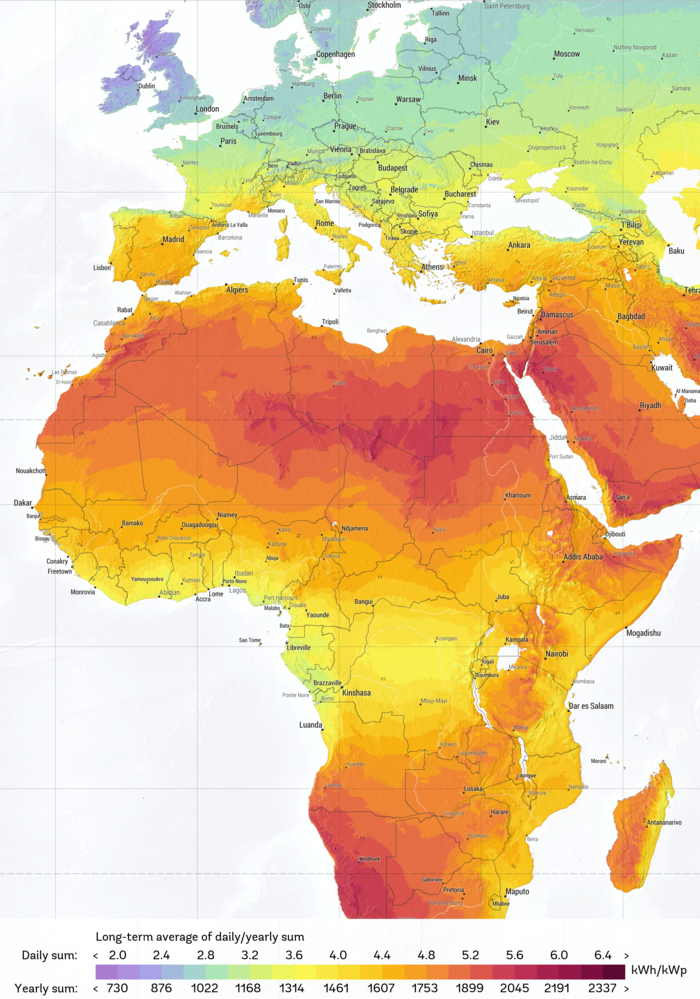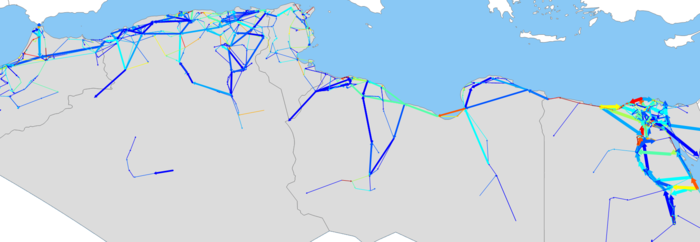Connecting Africa and Europe for Sustainable Development

Mitigation of climate change is one of the biggest present challenges, which is amongst others a main pillar of the Sustainable Development Goals (SDG) of the United Nations. The EU has already set pathways to battle climate change, but although the efforts are noteworthy and necessary Europe only accounts for about 10 % of the global CO2-emissions. Africa currently contributes about 3.5 % of the CO2 emissions and estimations show that the population will double and reach 2 billion people in 2050. Societal and economic development as well as quality education needs a stable and affordable electricity system and the needed stronger electrification of the whole continent has to be planned carefully in order to achieve higher standards of living whilst avoiding increasing CO2 emissions.
Challenges for the Integration of Renewable Energies
The integration of high shares of renewable energies into the electricity system shows many tasks which have to be solved. In contrast to the demand-oriented production of “conventional” power plants, the electricity production from renewable energies is volatile and supply-dependent. Therefore, flexibility measures as well as large-scale storage systems such as pumped hydro storage power plants and small-scale storage systems such as batteries in households become meaningful. Furthermore, places of potentially rich renewable energy sources are often located far away from the demand centres, which necessitates appropriate grid expansions. Aside technical challenges, also the economic market integration has to be looked at. On the one hand, huge needed investments have to be secured and, on the other hand, the electricity from renewables – showing mostly fixed costs – has to be integrated in existing markets based on variable costs, which requires new market approaches.
Simulation Model ATLANTIS
In order to analyse the transition towards an electricity system largely based on renewable energies from a technical as well as economic perspective, the Institute of Electricity Economics and Energy Innovation (IEE) has developed a techno-economic simulation model of the European electricity economy. This model called ATLANTIS covers the area of the ENTSO-E (European Network of Transmission System Operators for Electricity) and it combines a physical and an economic model approach (Figure 1).
The physical part includes a detailed database of the power plant park, the highvoltage transmission network as well as the nodal power demand and load flows are calculated based on a direct current (DC) load flow method. The economic model is used to determine market prices, electricity trading as well as balance sheets and profit and loss accounts of the modelled electricity companies. ATLANTIS allows the interdisciplinary and systemic analysis of the integration of renewable energies into the electricity system and just a few of the possible research questions cover the development of CO2 emissions, needed power plants as backup capacities (e.g. during dark and cold doldrums), needed grid enhancements and especially the costs regarding the integration of renewables and the associated consequences in the electricity markets.
Integrating Africa into ATLANTIS
The continent of Africa has large identified potentials regarding wind and particularly solar energy (Figure 2).

Photovoltaic potential of Europe and Africa.
The utilization of these potentials is currently still low, but the energy development plans of many African countries show that large expansions are planned in the future. It is also in the interest of Europe and the rest of the world that Africa uses a high share of renewable energy to provide electricity for the growing population.
The motivation of this investigation is that both continents could profit from a stronger connection and cooperation of the electricity markets of Europe and Africa. There is a strong interest of Europe to help develop the African continent, as can be seen by many initiatives like the African-EU partnership. The installation of renewable energy capacities is still a very expensive issue. On the one hand Europe could provide financial support but should also enable knowledge transfer based on the experiences made with the renewable energy integration in Europe. On the other hand, Europe could benefit from the use of some of the renewable energy potential of Africa to further move away from CO2-emission intensive conventional power plants and to further diversify its renewable energy production.
In order to simulate the electricity market of Africa IEE has started to implement the region into ATLANTIS on a country by country basis. As a first step, a thorough analysis of the electricity markets of the North African countries as well as some countries in the Middle East has been done and the necessary data has been added to the ATLANTIS database. In this first step the area around the Mediterranean Sea is now successfully modelled and simulations with the whole region including the ENTSO-E area are now being performed. This enables the investigation of different approaches, how a better interconnection between Africa and Europe could lead to an even better utilization of the renewable energy potential in Africa (Figure 3)

Example result of the load flow for North Africa.
First results show, that for the transfer of electricity over these long distances between Africa and Europe several new high voltage direct current (HVDC) lines are necessary.
The presented expansion of ATLANTIS to the whole Mediterranean region with a special focus on North Africa allows the investigation of several research questions like different meaningful development and decarbonisation scenarios, the effects of new power lines or power plants, impacts of different regulations and market designs or the development of regional electricity prices. Thus, ATLANTIS helps to find out the most beneficiary, prosperous and sustainable development strategies for the connected African and European electricity economy.




